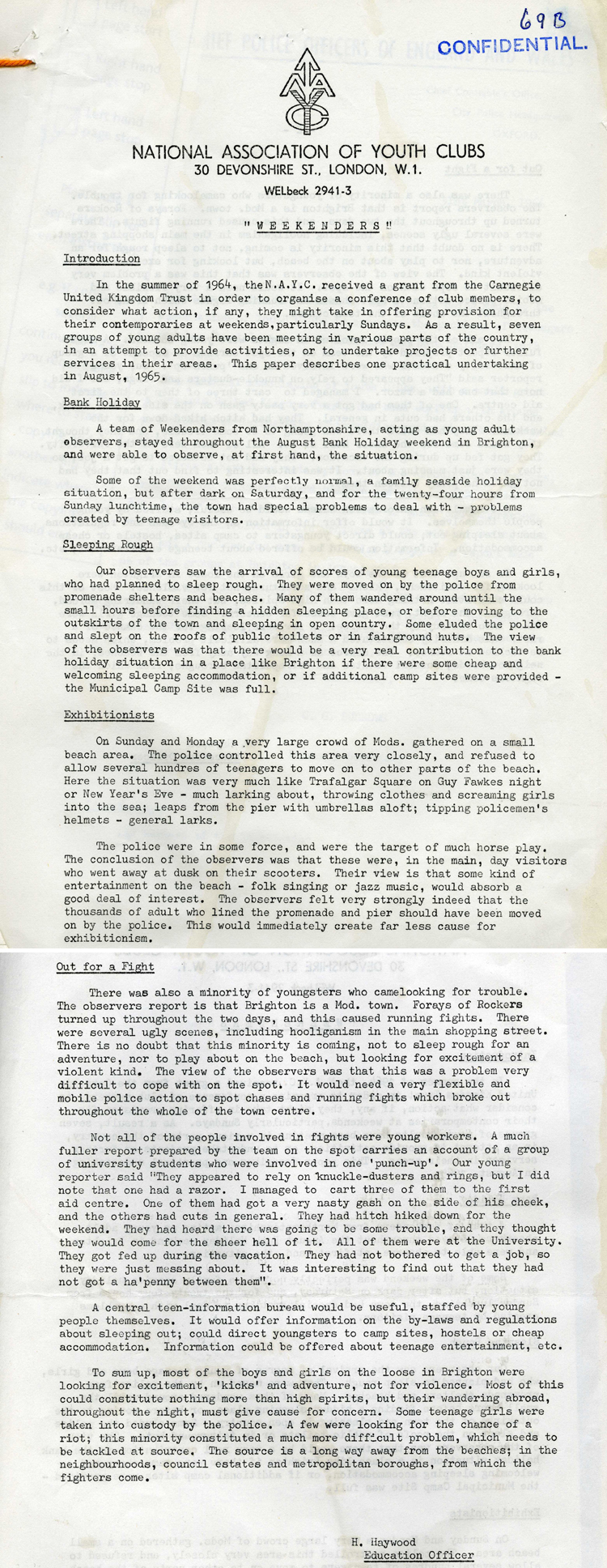
Report from the National Association of Youth clubs on youth behaviour on the August Bank Holiday in Brighton, 1965 (MEPO 2/10477)
Transcript
CONFIDENTIAL.
NATIONAL ASSOCIATION OF YOUTH CLUBS
30 DEVONSHIRE ST., LONDON, W.1.
WELbeck 2941-3
“WEEKENDERS”
Introduction
In the summer of 1964, the N.A.Y.C. received a grant from the Carnegie United Kingdom Trust in order to organise a conference of club members, to consider what action, if any, they might take in offering provision for their contemporaries at weekends, particularly Sundays. As a result, seven groups of young adults have been meeting in various parts of the country, in an attempt to provide activities, or to undertake projects or further services in their areas. This paper describes one practical undertaking in August, 1965.
Bank Holiday
A team of Weekenders from Northamptonshire, acting as young adult observers, stayed throughout the August Bank Holiday weekend in Brighton, and were able to observe, at first hand, the situation.
Some of the weekend was perfectly normal, a family seaside holiday situation, but after dark on Saturday, and for the twenty-four hours from Sunday lunchtime, the town had special problems to deal with – problems created by teenage visitors.
Sleeping Rough
Our observers saw the arrival of scores of young teenage boys and girls, who had planned to sleep rough. They were moved on by the police from promenade shelters and beaches. Many of them wandered around until the small hours before finding a hidden sleeping place, or before moving to the outskirts of the town and sleeping in open country. Some eluded the police and slept on the roofs of public toilets or in fairground huts. The view of the observers was that there would be a very real contribution to the bank holiday situation in a place like Brighton if there were some cheap and welcoming sleeping accommodation, or if additional camp sites were provided – the Municipal Camp Site was full.
Exhibitionists
On Sunday and Monday a very large crowd of Mods, gathered on a small beach area. The police controlled this area very closely, and refused to allow several hundre[d]s of teenagers to move on to other parts of the beach. Here the situation was very much like Trafalgar Square on Guy Fawkes night or New Year’s Eve – much larking about, throwing clothes and screaming girls into the sea; leaps from the pier with umbrellas aloft; tipping policemen’s helmets – general larks.
The police were in some force, and were the target of much horse play. The conclusion of the observers was that these were, in the main, day visitors who went away at dusk on their scooters. Their view is that some kind of entertainment on the beach – folk singing or jazz music, would absorb a good deal of interest. The observers felt very strongly indeed that the thousands of adult who lined the promenade and pier should have been moved on by the police. This would immediately create far less cause for exhibitionism.
Out for a Fight
There was also a minority of youngsters who came looking for trouble. The observers report is that Brighton is a Mod town. Forays of Rockers turned up throughout the two days, and this caused running fights. There were several ugly scenes, including hooliganism in the main shopping street. There is no doubt that this minority is coming, not to sleep rough for an adventure, nor to play about on the beach, but looking for excitement of a violent kind. The view of the observers was that this was a problem very difficult to cope with on the spot. It would need a very flexible and mobile police action to spot chases and running fights which broke out throughout the whole of the town centre.
Not all of the people involved in fights were young workers. A much fuller report prepared by the team on the spot carries an account of a group of university students who were involved in one ‘punch-up’. Our young reporter said “They appeared to rely on knuckle-dusters and rings, but I did note that one had a razor. I managed to cart three of them to the first aid centre. One of them had got a very nasty gash on the side of his cheek, and the others had cuts in general. They had hitch hiked down for the weekend. They had heard there was going to be some trouble, and they thought they would come for the sheer hell of it. All of them were at the University. They got fed up during the vacation. They had not bothered to get a job, so they were just messing about. It was interesting to find out that they had not got a ha’penny between them”.
A central teen-information bureau would be useful, staffed by young people themselves. It would offer information on the by-laws and regulations about sleeping out; could direct youngsters to camp sites, hostels or cheap accommodation. Information could be offered about teenage entertainment, etc.
To sum up, most of the boys and girls on the loose in Brighton were looking for excitement, ‘kicks’ and adventure, not for violence. Most of this could constitute nothing more than high spirits, but their wandering abroad, throughout the night, must give cause for concern. Some teenage girls were taken into custody by the police. A few were looking for the chance of a riot; this minority constituted a much more difficult problem, which needs to be tackled at source. The source is a long way away from the beaches; in the neighbourhoods, council estates and metropolitan boroughs, from which the fighters come.
J. Haywood
Education Officer
